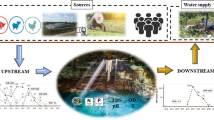Abstract
Cemeteries are generally considered low-risk landfills and are, therefore, not adequately governed in terms of minimum requirements for engineering geological and hydrogeological investigations. With the decay of human bodies, the bulk of the contaminant load is typically present within one year of burial and decreases over time. Further controls include adsorption of pathogens and particulates to soil in the vadose zone, and eventual breakdown in changing aerobic and anaerobic subsurface environments. A case study is presented where a cemetery has been active for decades and contains in excess of 18,000 human bodies. With recent expansion, water seepage into newly excavated burial pits was identified, and all further development has ceased. Trial pitting and detailed soil profile descriptions are used to infer hydrological interaction at the site and to address possible contamination pathways. Future work is recommended with respect to water quality, although valuable insight is provided into the consequences of improper ground investigation prior to development. Final comments are made regarding provisional guidelines in the forms of a cost-effort-risk screen and a multi-faceted Vadose Zone Assessment Protocol.








Similar content being viewed by others
References
Brink ABA (1983) Engineering geology of Southern Africa, vol 3. Building Publications, Pretoria, The Karoo Supergroup, p 320
Croucamp L, Richards N (2002) Guidelines for cemetery site selection. Council for Geoscience, Pretoria
DEAT (Department of Environmental Affairs and Tourism) (1989) Environmental Conservation Act No 73. Government Printer, Pretoria
Dent BB, Knight MJ (1998) Cemeteries: a special kind of landfill. The Context of their Sustainable Management. In: Proceedings: Groundwater: Sustainable Solutions (International Association of Hydrogeologists, Melbourne, February 1998), pp 451–456
DWA (Department of Water Affairs) (1998) National Water Act No 36. Government Printer, Pretoria
DWA [Department of Water Affairs]. (Retrieved 2010) Water Quality Management Policy with regard to the Management of and Control over Cemeteries as a Source of Water Pollution. Document number: GraveR. Available on the Internet at http://www.dwaf.gov.za/Documents/Policies/WDD/Cemetery.pdf.2pages
EA (Environmental Agency): Science group air, land & water (2004) Assessing the groundwater pollution potential of cemetery developments. Product Code SCHO0404BGLA-E-P. Environmental Agency, Bristol
Engelbrecht J (2000) Goundwater pollution for cemeteries. CSIR, Pretoria
Fisher G (1992) Selection criteria for the placing of cemetery sites. Geological Survey of South Africa, Johannesburg
Fisher GJ (1994) The selection of cemetery sites in South Africa. In: Proceedings of the 4th Terrain Evaluation and Data Storage Symposium, Midrand
Fisher G, Croucamp L (1993) Groundwater contamination and its consequences resulting from the indiscriminate placing of cemeteries in third world context, vol 1. Africa needs Groundwater Convention, Johannesburg
Hall BH, Hanbury R (1990) Some geotechnical considerations in the selection of cemetery sites. IMIESA March 1990:2125
Johnson MR, Van Vuuren CJ, Visser JNJ, Cole DI, Wickens H, De V, Christie ADM, Roberts DL, Brandl G (2009) Sedimentary rocks of the Karoo supergroup. In: Johnson MR, Anhaeusser CR, Thomas RJ (eds) The geology of South Africa. Geological Society of South Africa, Johannesburg/Council for Geoscience, Pretoria, pp 461–500
NIEA [Northern Ireland Environment Agency] (2012) Cemeteries, burials & the water environment: guidance notes. Available on the Internet at http://www.ni-environment.gov.uk
WHO (World Health Organisation): Regional Office for Europe (1996) The impact of cemeteries on the environment and public health: an introductory briefing. Document EUR/HFA target 23. World Health Organisation, Copenhagen
Young CP, Blackmore KM, Reynolds P, Leavens A (2002) Pollution potential of cemeteries: draft guidance. R&D Technical Report P223. Environmental Agency, Bristol
Acknowledgments
The author wishes to acknowledge the Water Research Commission (WRC) of South Africa for funding of project K5/2052 on Multidisciplinary Vadose Zone Hydrology. Additional acknowledgement is extended to all parties involved in the project for help with data collection and for discussion about the topic, as well as the valuable input from the anonymous reviewers.
Author information
Authors and Affiliations
Corresponding author
Rights and permissions
About this article
Cite this article
Dippenaar, M.A. Towards a multi-faceted Vadose Zone Assessment Protocol: cemetery guidelines and application to a burial site located near a seasonal wetland (Pretoria, South Africa). Bull Eng Geol Environ 73, 1105–1115 (2014). https://doi.org/10.1007/s10064-014-0635-3
Received:
Accepted:
Published:
Issue Date:
DOI: https://doi.org/10.1007/s10064-014-0635-3




